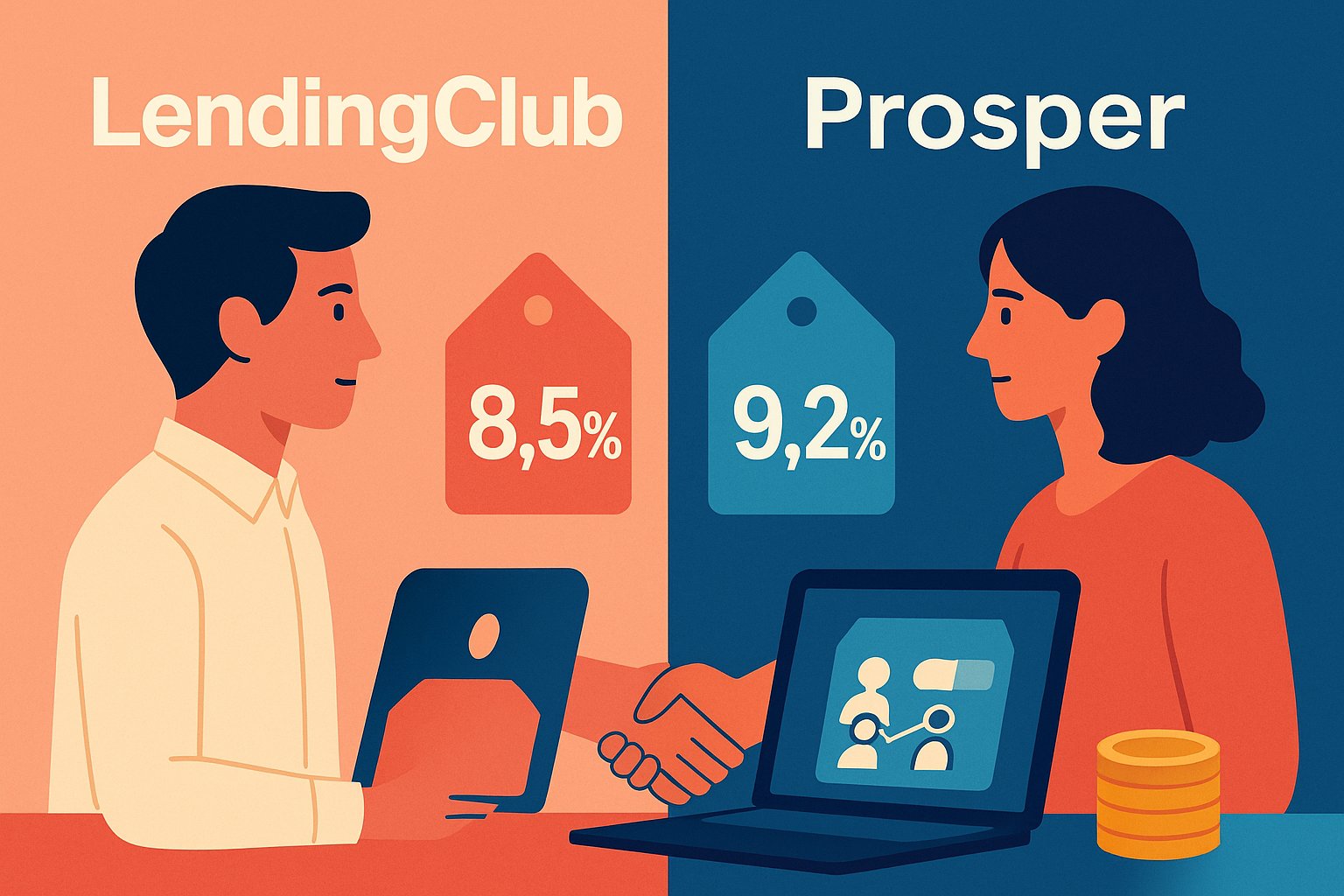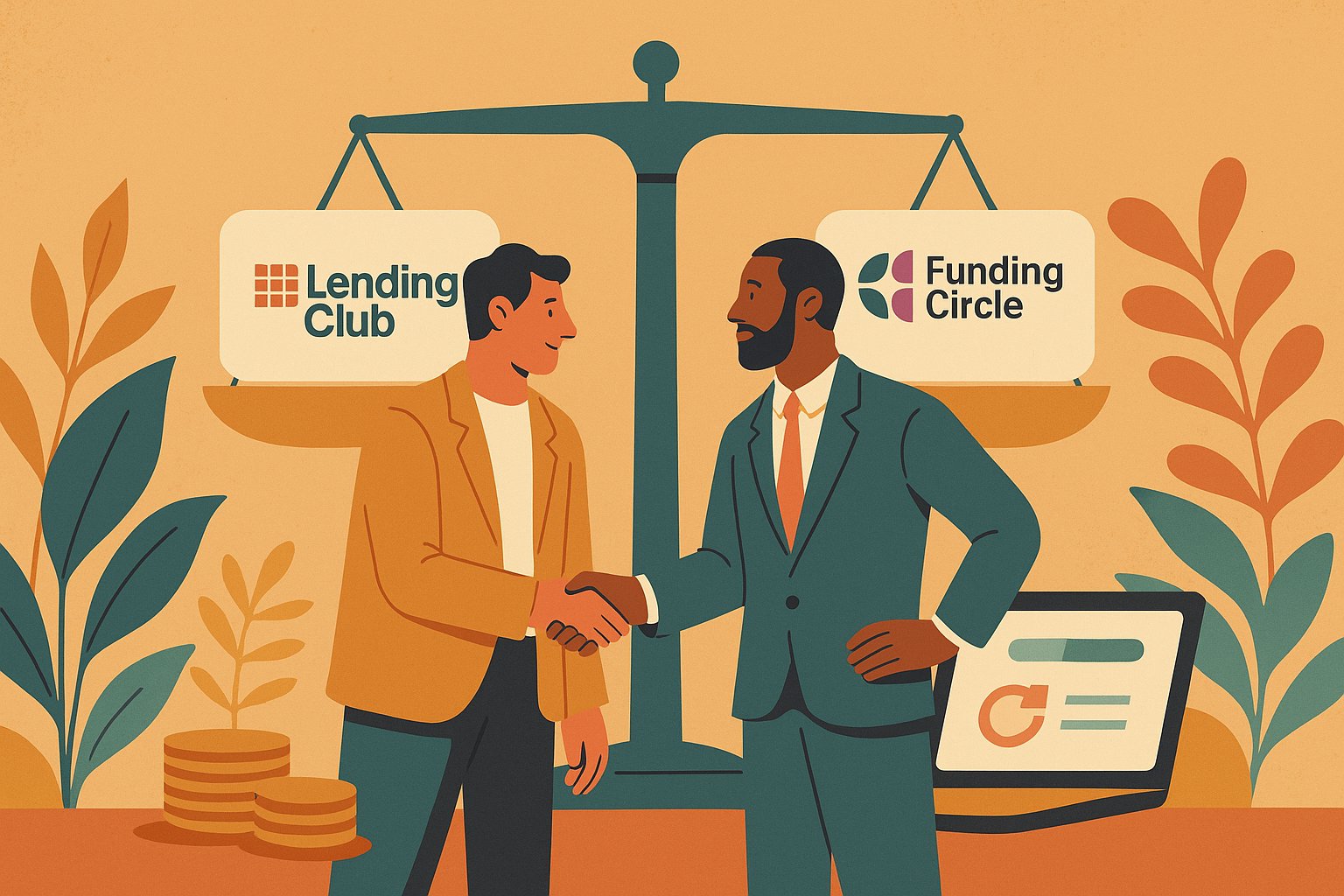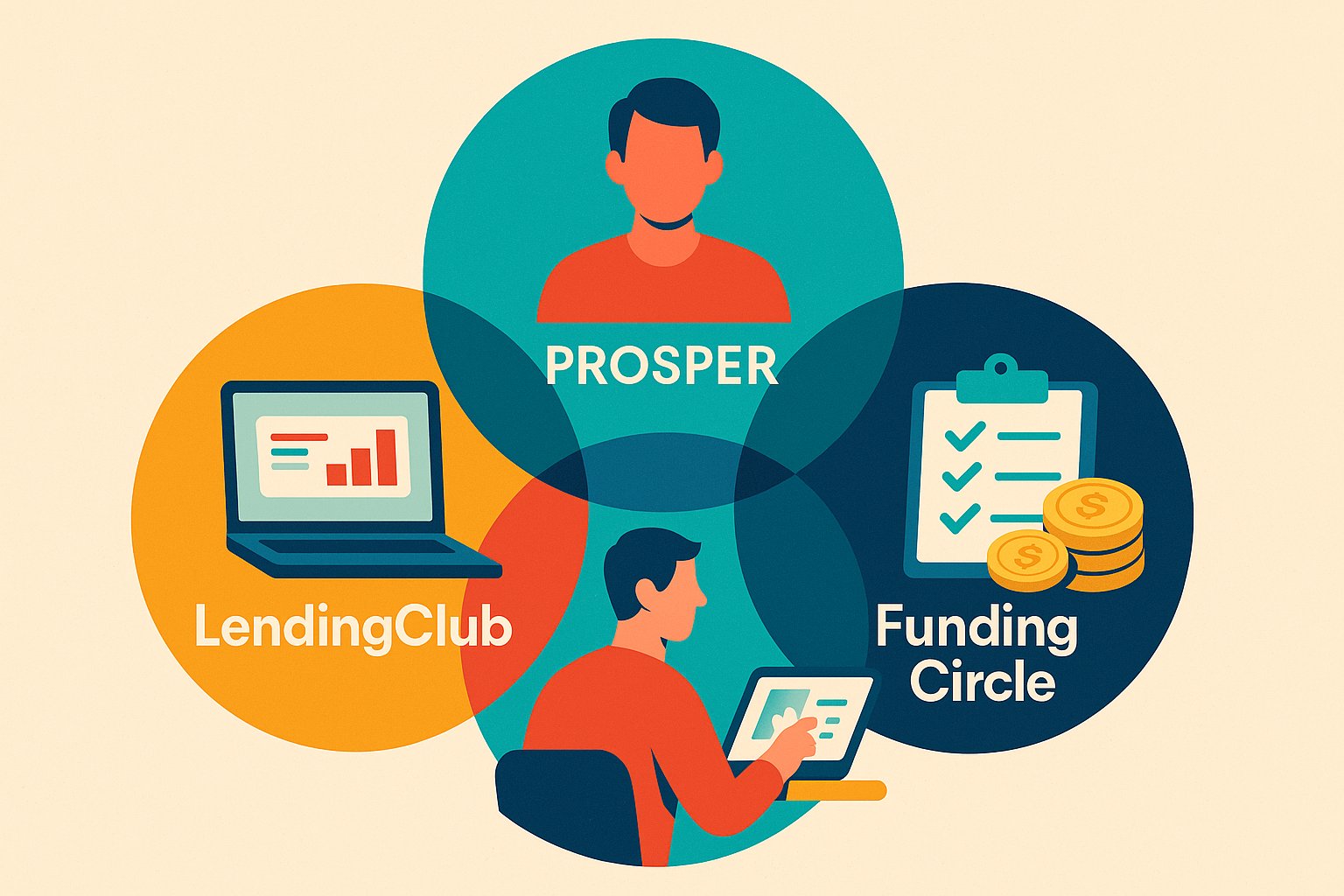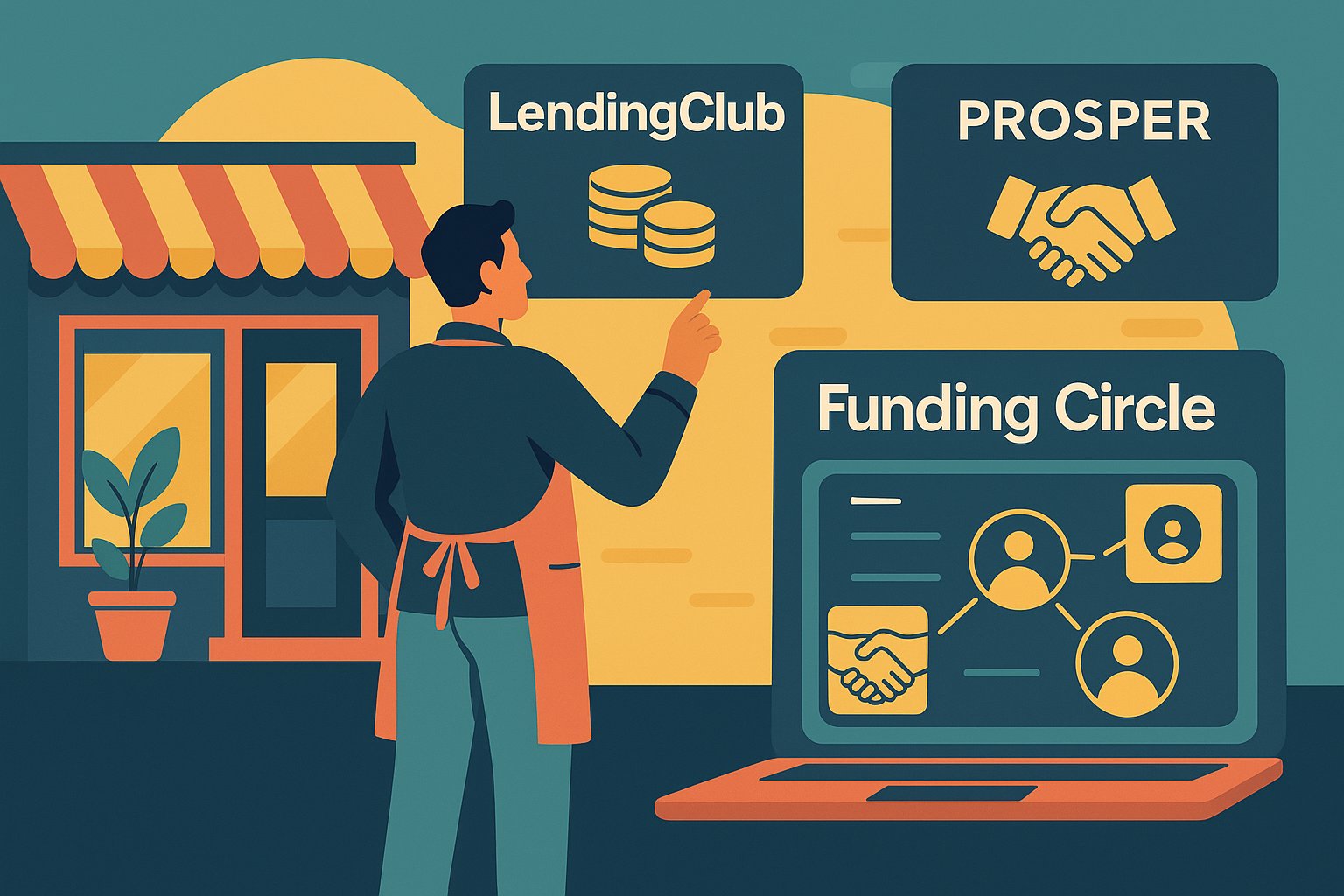Navigating the Borrowing Frontier: LendingClub vs. Prosper Unveiled
Securing a personal loan in today’s myriad lending environment can feel like charting untested waters. As traditional banks tighten underwriting standards, borrowers increasingly turn to peer-to-peer platforms that match individual lenders with creditworthy applicants. Two of the most prominent P2P players—LendingClub and Prosper—stand head-to-head, promising competitive interest rates, streamlined application processes, and transparent terms. Yet beneath the surface of these alluring promises lies a more nuanced reality: rates can vary widely depending on credit profile, loan amount, and market conditions. In this exploration—LendingClub vs. Prosper: Which Offers Better Rates for Personal Loans—we’ll look into each platform’s rate structures, eligibility criteria, and borrower experiences. By the end, you’ll have a clear roadmap to determine which lender could offer you the best rate for your unique financial circumstances.
The Peer-to-Peer Paradigm: How Modern Lending Works
Before comparing specific rates, it’s essential to grasp the mechanics of peer-to-peer lending. Unlike conventional banks that rely on centralized balance sheets, peer-to-peer platforms crowdsource loan capital from individual investors seeking diversified returns. When you apply for a personal loan on LendingClub or Prosper, your creditworthiness undergoes rigorous evaluation through proprietary algorithms and credit bureau data. If approved, your loan request joins a marketplace listing where multiple investors pledge portions of the total amount. This model democratizes lending: investors benefit from portfolio diversification, while borrowers often access funds more quickly than through traditional channels. Because interest rates hinge on a myriad of factors—your credit score, income, debt-to-income ratio, and prevailing economic trends—both LendingClub and Prosper tailor APRs to each borrower’s risk profile. Consequently, understanding how each platform constructs its rate tiers is crucial to discerning which provides superior borrowing costs.
LendingClub’s Rate Blueprint: Credit Grades, APR Bands, and Fee Structures
LendingClub pioneered the P2P landscape in 2007 and has since refined its underwriting engine to balance borrower needs with investor expectations. The cornerstone of LendingClub’s rate structure lies in its credit grading system, which assigns applicants letter-based grades—from A1 for prime borrowers to G5 for higher-risk profiles. Each grade corresponds to an APR range, which as of mid-2025 generally spans from approximately 7 percent for top-tier borrowers to upwards of 32 percent for lower-tier categories. Crucially, LendingClub factors in variables such as credit score, total indebtedness, length of credit history, and employment stability when determining your initial credit grade. Once the grade is assigned, the platform calculates a specific APR within that bracket, reflecting your precise risk level.
Origination fees also influence the total cost of borrowing. LendingClub levies an origination fee between 1 and 6 percent of the loan principal, deducted from the disbursed amount. For example, if you qualify for a $10,000 loan at 8 percent APR and a 4 percent origination fee, you would receive $9,600 up front but owe interest on the full $10,000. Although this fee structure may initially appear steep, it compensates investors and underwrites the platform’s operational costs. Importantly, LendingClub does not penalize early repayments—allowing borrowers to reduce interest expenses if they pay off loans ahead of schedule. Armed with this understanding of grading, APR bands, and fees, borrowers can gauge where they might sit on LendingClub’s rate spectrum.
Prosper’s Rate Formula: Risk Assessment, APR Tiers, and Community Dynamics
Prosper, which launched in 2006, stands as another pillar of the peer-to-peer lending revolution. Like LendingClub, Prosper categorizes borrowers into risk-based tiers—from AA and A for highly qualified applicants to E, HR, and I for those with thicker risk profiles. Each tier aligns with an APR range that, as of 2025, typically begins around 7.5 percent for top-tier borrowers and can escalate to nearly 35 percent for subprime candidates. Prosper’s comprehensive evaluation incorporates credit score, debt-to-income ratio, past delinquencies, and public records. Importantly, Prosper also weighs “soft” factors such as existing relationship tenure—if you’ve previously repaid a Prosper loan on time, you may enjoy a modest APR boost in subsequent applications.
Origination fees on Prosper’s platform fluctuate between 1 and 6 percent, mirroring LendingClub’s approach. However, Prosper distinguishes itself by encouraging borrowers to build robust profiles—complete with transparent storytelling about how the loan will be used. This narrative-driven component appeals to socially minded investors who want more context than raw financials alone. When multiple investors bid on your loan, the final APR can inch toward the lower bound of your assigned tier, especially if your profile generates strong demand. Conversely, if investor demand is tepid, you may receive an APR closer to the upper end. As a result, Prosper’s rates can exhibit greater variability than LendingClub’s, influenced by both your credit profile and investor sentiment on any given day.
Scrutinizing APR Ranges: Side-by-Side Comparison
While precise APRs hinge on individual factors, a high-level comparison between LendingClub and Prosper’s published rate brackets offers initial insights. For borrowers with excellent credit—FICO scores above 750—both platforms advertise APR ranges roughly between 7 and 10 percent. Historically, LendingClub’s top-tier rates have edged slightly lower—occasionally by a few tenths of a percent—owing to its larger institutional investor base that bids aggressively for prime loans. Prosper, on the other hand, has leveraged its community-focused ethos to drive competitive rates for mid-tier borrowers (FICO scores between 700 and 749), often undercutting LendingClub by a small margin. For subprime borrowers (FICO below 650), both platforms tend to converge, with rates soaring above 25 percent. Here, differences blur: origination fees and borrower narratives can sway the final APR more than the nominal tier bracket.
Concretely, a borrower with a 720 credit score seeking a $15,000 loan might see LendingClub offer an APR range of 10 to 13 percent, while Prosper might quote 9.5 to 12.5 percent. The final APR on Prosper could benefit from robust investor demand if the borrower’s project resonates with community interests—such as funding a small business expansion or consolidating debt to improve financial health. Conversely, LendingClub’s streamlined digital underwriting and abundant institutional bids may deliver slightly lower starting rates, especially during periods when banks pull back from consumer lending. Ultimately, dissecting these APR ranges side-by-side clarifies that top-tier borrowers may lean toward LendingClub for marginally lower baseline rates, whereas mid-tier applicants might find Prosper’s investor-led dynamic more beneficial.
The Hidden Components: Origination Fees, Prepayment Policies, and Loan Amount Impact
Nominal APRs only tell part of the story. Two equally critical factors are origination fees and prepayment policies. On both LendingClub and Prosper, origination fees range from 1 to 6 percent of the loan principal, with higher fees levied on riskier profiles. Because this fee is subtracted upfront, borrowers must remember that they receive less than the nominal loan amount but pay interest on the full amount borrowed. For example, if you qualify for a $20,000 loan at 8 percent APR with a 4 percent origination fee, you’d receive $19,200 while owing interest on $20,000. That discrepancy effectively raises the effective APR beyond the advertised rate. Comparing platforms, LendingClub’s fee tiers can be more favorable for high-balance loans—often capping at 5 percent for loans above $35,000—whereas Prosper may charge a full 6 percent on similar profiles unless you’ve established prior repayment success.
Prepayment policies also shape late-stage borrowing costs. LendingClub—true to its ethos of borrower flexibility—does not impose prepayment penalties. If you experience an unexpected cash infusion, you can accelerate payments without incurring extra fees, thereby trimming total interest paid. Prosper similarly allows prepayment without penalty, though some borrowers report that early payoff tabulation—calculating daily interest accruals—can slightly vary between platforms, affecting the exact amount you save. Finally, loan amounts play a pivotal role. Smaller loans (below $5,000) often drag APRs higher, since fixed fees consume a larger percentage of the principal. Conversely, high-balance loans (above $25,000) tend to enjoy slightly lower APRs if your credit profile merits top-tier grading. While both platforms offer loans ranging from $2,000 to $40,000, borrowers seeking the upper end may find marginally better rate thresholds on LendingClub, thanks to its broader institutional funding pool.
Eligibility Gatekeepers: How Credit and Income Requirements Affect Rates
Eligibility criteria are the gatekeepers that determine whether you gain entry to favorable rate tiers—or face higher borrowing costs. On LendingClub, applicants must hold a minimum FICO score of 660 and demonstrate at least two years of credit history. LendingClub also mandates a debt-to-income ratio below 40 percent and verifiable employment or income sources. Prosper’s baseline requirements are slightly broader: a minimum FICO score of 640 and one year of credit history. Prosper likewise examines debt-to-income ratios but is sometimes more lenient on applicants with nontraditional income streams—such as freelancing or gig work—as long as you can document consistent revenue over the past 12 months.
These differences in baseline criteria directly influence rate outcomes. If, for example, your FICO score sits at 645, Prosper might extend a modest-tier loan with an APR somewhere between 18 and 22 percent, whereas LendingClub could decline your application outright or offer a much higher rate on a G5 grade if they approve. This flexibility makes Prosper a more attractive venue for near-prime borrowers seeking marginally better rates than high-cost credit unions or subprime lenders. Conversely, if you have a pristine credit history—FICO above 760—LendingClub’s stricter gatekeeping ensures that only high-quality borrowers reach the top APR brackets, enabling the platform to maintain lower rates for prime consumers. Thus, assessing your credit profile relative to each platform’s eligibility thresholds becomes an essential first step in rate comparison.
Illustrative Scenarios: Rate Comparisons for Real-World Borrowers
Numbers often resonate more than abstract theory. Let’s consider three hypothetical borrowers—each illustrating how LendingClub and Prosper’s rates might diverge:
1. The Prime Professional (FICO 780, Annual Income $120,000): Seeking $20,000 to consolidate debt, this borrower qualifies easily under both platforms’ prime thresholds. LendingClub might extend an APR of 7.5 percent with a 3 percent origination fee, whereas Prosper might quote 7.9 percent APR with a 4 percent fee. Because LendingClub’s institutional bids outweigh community appetite for prime loans, the borrower ends up paying slightly less in total interest over a 36-month term.
2. The Near-Prime Freelancer (FICO 700, Annual Income $60,000, Variable Monthly Earnings): Looking for $10,000 to fund a home office upgrade, this borrower encounters variability. On LendingClub, the platform’s reliance on traditional employment verification might assign a B3 grade, translating to an APR of roughly 13 percent with a 5 percent fee. Prosper, valuing narrative around freelance success, might classify them as C1—offering an APR of 12 percent with a 5 percent origination fee. Here, Prosper’s community-driven underwriting yields a slightly lower effective APR, rewarding nontraditional income documentation.
3. The Borderline Borrower (FICO 640, Annual Income $40,000, High Debt-to-Income Ratio): In need of $5,000 for medical expenses, this borrower faces steeper hurdles. LendingClub may decline outright or assign a G5 grade with an APR north of 34 percent and maximum origination fees. Prosper, with lower minimum credit requirements, could approve them at a 30 percent APR with a 6 percent fee—still costly, but marginally preferable. Ultimately, Prosper’s risk tolerance at the subprime level can deliver a better effective rate for those on the edge of qualification.
These scenarios underscore that top-tier borrowers likely benefit slightly more from LendingClub’s deep institutional funding pool, while near-prime and borderline applicants may find Prosper’s community-driven model more accommodating—albeit still at elevated rates. Borrowers must therefore contextualize advertised APR ranges within their specific credit and income profiles.
Customer Experience and Processing Speeds: Beyond Just APR
While interest rates dominate the conversation, the broader borrowing experience can influence your ultimate cost and convenience. LendingClub typically completes underwriting and funds disbursement within five business days—sometimes faster if documentation is flawless. The platform’s intuitive online dashboard provides clear payment schedules and amortization tables, enabling borrowers to visualize total interest costs over the life of the loan. LendingClub’s mobile app further streamlines payment tracking and early payoff requests.
Prosper’s timeline is similarly efficient, often finalizing approvals within three to four days. However, because Prosper relies heavily on individual investor bids, rare instances of low investor demand can delay disbursement by a few extra days. Prosper’s community forum, on the other hand, offers a unique value-add: borrowers can solicit peer advice on debt management, ask questions about loan purpose strategies, or share experiences with repayment hurdles. This sense of camaraderie—while not directly reducing APR—can indirectly improve borrower behavior, encouraging on-time payments and overall financial accountability. Additionally, Prosper’s robust customer support team often provides personalized rate negotiation tips—helping some borrowers refine their credit profiles for lower future APRs. When weighing LendingClub versus Prosper, consider these peripheral factors: how quickly you need funds, the quality of customer support, and whether community engagement could tangibly improve your repayment outcomes.
Hidden Costs and Fine Print: Fees, Late Payments, and Insurance
APR and origination fees form the headline numbers, but savvy borrowers also parse hidden costs lurking in the fine print. Both LendingClub and Prosper charge late payment fees—typically $15 or 5 percent of the missed payment, whichever is greater. If you miss multiple payments, platforms may report delinquencies to credit bureaus, thereby compounding your cost of borrowing in subsequent loans. Additionally, some borrowers overlook optional payment protection products—debt protection or credit insurance—offered at a premium. While these add-ons can shield you from hardship (such as job loss or disability), they inflate your total loan cost. Before opting in, compare these protection fees against potential out-of-pocket expenses if disaster strikes. LendingClub’s payment protection, for instance, may add an extra 1.5 percent to your APR; Prosper’s equivalent insurance can tack on up to 2 percent. Assess these options critically, balancing peace of mind against additional borrowing costs.
Making Your Choice: Balancing Rate, Service, and Long-Term Goals
After dissecting APRs, origination fees, eligibility gates, and customer experiences, how should you choose between LendingClub and Prosper? First, clarify your credit profile. If you boast an excellent FICO score (above 750) and stable traditional income, LendingClub likely offers marginally lower headline rates and minimal friction due to its robust institutional underwriting. Conversely, if your credit score hovers in the 640–700 range or you rely on variable income sources, Prosper’s community-driven approach may render a more favorable effective APR while granting flexibility in income documentation.
Next, consider your timeline. If you need funds within a tight window—say, to seize a fleeting business opportunity—LendingClub’s superior funding consistency can be a boon. Prosper still operates swiftly, but occasional lags in investor demand can add days to disbursement. Finally, factor in ancillary benefits: if you crave peer support, financial education, and debt management insights, Prosper’s communal ethos could enhance your borrowing journey and improve repayment discipline. In contrast, LendingClub’s polished digital tools and transparent dashboards serve borrowers who value streamlined, data-driven interactions without community engagement. By weighing these factors against your long-term financial goals—such as rebuilding credit, consolidating debt, or financing home renovations—you can align your platform choice with both immediate and future objectives.
Top Tips to Secure the Lowest Possible APR
Regardless of platform, there are universal strategies to unlock the most competitive rates:
• Boost your credit score: A higher FICO score directly correlates with lower APR tiers. Pay down credit card balances, settle outstanding collections, and avoid opening new lines of credit in the months leading up to your application.
• Lower your debt-to-income ratio: Lenders scrutinize DTIs closely. Reducing monthly debt obligations—through partial prepayments or negotiated settlements—can shift you into a lower-risk category.
• Optimize loan amount and term: While longer terms often yield lower monthly payments, they increase total interest paid. Conversely, shorter terms come with slightly lower APRs, thanks to reduced risk exposure. Borrow only what you need, and select the shortest feasible term to minimize interest.
• Shop rates quietly: Each platform performs a soft credit inquiry during prequalification—so comparing multiple rate offers across lenders won’t ding your credit. Gather prequalification quotes from both LendingClub and Prosper, then choose the most advantageous APR and fee combination.
• Avoid high origination fees: If you’re on the cusp of two fee tiers (e.g., 4 percent vs. 5 percent), reducing your requested loan amount slightly might keep your fee in the lower bracket, trimming thousands off total borrowing costs.
By systematically implementing these tactics, borrowers amplify their chances of securing top-tier rates—regardless of whether they opt for LendingClub or Prosper.
Looking Ahead: Future Trends in Peer-to-Peer Lending Rates
As the fintech landscape continues evolving, both LendingClub and Prosper are poised to refine their rate algorithms and fee structures. Artificial intelligence and machine learning are beginning to play larger roles in underwriting, enabling platforms to ingest alternative data—like rental payment histories, utility bills, and social media indicators—to more accurately predict borrower risk. This expanded data pool could unlock lower APRs for underbanked individuals who lack extensive traditional credit histories. Furthermore, institutional investor appetite may shift, especially in response to macroeconomic trends: if interest rates across the economy rise, peer-to-peer APRs may climb in tandem; conversely, a deflationary environment could tighten spreads and lower borrower costs.
For borrowers, staying agile and informed will be paramount. Monitoring announcements about new underwriting models, fee reductions, or expanded credit criteria can reveal opportune moments to apply. Additionally, as regulatory oversight intensifies—potentially capping origination fees or enforcing stricter transparency mandates—both LendingClub and Prosper may adjust rate structures to comply. By keeping an eye on these developments, borrowers can time their applications strategically, ensuring they benefit from the lowest possible rates during an ever-shifting P2P environment.
Charting Your Course: Final Thoughts on Securing the Best Rate
Deciding between LendingClub and Prosper hinges on a constellation of factors: your credit score, income consistency, loan amount, term preferences, and appetite for community engagement. While LendingClub generally edges out with marginally lower APRs for prime borrowers, Prosper’s more inclusive eligibility criteria and narrative-driven approach can deliver competitive rates to near-prime applicants. Origination fees, prepayment policies, and platform-specific perks further refine the total cost of borrowing. To navigate this landscape successfully, borrowers should obtain prequalification quotes from both platforms, optimize credit profiles beforehand, and select loan terms aligned with cash flow realities.
Ultimately, the “better rate” is not merely the lowest headline APR—it’s the one that best balances upfront fees, repayment flexibility, and overall borrowing experience relative to your unique financial profile. By blending diligent research, transparent communication, and strategic timing, you can transform either LendingClub or Prosper into a catalyst for personal financial growth—securing the capital you need without overextending your future budget. As you embark on this journey, remember that sound borrowing decisions lay the foundation for improved credit health, financial resilience, and long-term prosperity. Good luck as you compare rates, weigh options, and chart a course toward more affordable, accessible personal loans in the dynamic world of peer-to-peer lending.




